
April 7, 2025: Commended cutoff at 210.
The Commended Student cutoff for the class of 2026 is confirmed at a Selection Index of 210. This was the exact level Compass projected in November based on PSAT results. This means that changes to our estimated ranges for Semifinalist cutoffs are minimal. The extreme edges — upper and lower — of our estimated ranges are a bit less probable, but the “Most Likely” scores are unchanged. The fact that Compass’s Commended cutoff estimate was correct, however, does not mean that the Semifinalist projections will prove just as accurate — there is always variability at the state level. Juniors scoring at or above 210 on the PSAT/NMSQT will be Commended Students or Semifinalists, but announcements are not made until September. Semifinalist cutoffs will not be revealed until late August or early September.
November 13: Updated with final wave of PSAT scores.
College Board released scores in three waves depending on when students took the PSAT. We have now received scores summaries for all three waves. It is possible that some late scores will still dribble in, but we are not expecting any changes. The results point to a strong upward trend in cutoffs for the class of 2026. You are welcome to jump to the table of estimates below, but we encourage students and families to read more about how we came to those estimates. For more information on the National Merit Program, in general, you may want to read Compass’s National Merit Scholarship Program Explained. If you want to browse almost two decades’ worth of cutoffs, you can find them in Compass’s National Merit Historical Cutoffs.
What is a Semifinalist Cutoff?
Each year almost 17,000 juniors are named Semifinalists in the National Merit Scholarship Program and continue on in the hopes of being one of the 15,000 Finalists and, eventually, one of the 7,500 scholarship recipients. The score needed to qualify as a Semifinalist varies by state and is known as the “cutoff.” Every student scoring at or above the Semifinalist cutoff qualifies. The cutoff is not based on a student’s overall PSAT score but on the Selection Index. The Selection Index is listed on a student’s PSAT score report. It can be calculated by doubling the ERW score, adding the Math score, and then dividing the sum by 10. For example, a 720 ERW / 730 M would have a Selection Index of (720 x 2 + 730)/10 = 217. For the class of 2025, cutoffs ranged from 208 to 223.
What is a Commended Student Cutoff?
If you performed well on the PSAT but do not qualify as a Semifinalist, you have the opportunity to be named as a Commended Student. Unlike the Semifinalist cutoffs, the Commended cutoff is set nationally. For last year’s class it was 208. Approximately 36,000 students are named Commended Students each year.
Why does Compass believe that we are likely to see cutoffs, as a whole, go up?
College Board releases very little data about score distribution. The number of top scorers is the most critical piece of information that we get this early in the process. While we do not know the number of students scoring at a particular Selection Index, we do know the number of students scoring in the 1400-1520 range, which roughly correlates to Selection Indexes of 210-228. The class of 2026 ranks 4th in the ten years since the PSAT scoring was overhauled, and this year sees the highest ever percentage of top scores. The number of Semifinalists and Commended students are capped, so cutoffs are likely to rise. But not all cutoffs. The numbers we have seen are at the national level and there is always churn at the state level. What we believe, however, is that more cutoffs will go up than down.
There is a good correlation between the 1400-1520 band of students and the Commended Student score. We believe that the Commended cutoff will come in between 209 and 211, with a 210 being most likely. Based on our historical archive of Semifinalist and Commended cutoffs, we believe that the average Semifinalist cutoff will go up this year.
Will I find out my status right away?
No. In fact, students don’t learn of Semifinalist status until September of senior year. Compass tracks data on current year performance and historical records to provides estimates and updates between PSAT score release and the Semifinalist announcements. Last year — the first year of the digital PSAT — saw a noticeable uptick in scores. Only one state — South Dakota — saw a lower cutoff versus the previous year’s. Was this a onetime quirk? Based on early results for the class of 2026, we do not believe that it was. The upward trend — whether due to the new test format, recovery from COVID-era learning loss, or other factors — appears to be continuing.
One mistake students make is thinking that the cutoff for one year will be the same in the next year. Cutoffs change every year, sometimes by as much as 5 or 6 points (granted, that’s unusual). Compass emphasizes an Estimated Range, which is likely to include the ultimate cutoff. Within that range, we do provide our Most Likely. That score represents our best estimate based on the known factors, but there are many unknown factors. Most of our PSAT performance data are for national results. So we can usually peg the Commended cutoff within a point or two. States, however, can move in different directions. More Alaskan students may test this year. Some strong Rhode Island prep schools may have decided to stop offering the PSAT. A COVID outbreak in Montana could mean more students using Alternate Entry and entering the competition using SAT scores. Below is a table that shows how many states in each of the last 17 years saw increases, decreases, or no change. There has never been a year where even half of all state cutoffs remain unchanged.
The chart below divides the 50 states into those that saw increases (blue), those that remained unchanged (gray), and those that saw declines (red).
Historically, a change in cutoff is more likely than not. Over the decade from 2015 – 2024, Semifinalist cutoffs remained unchanged only about one-third of the time.
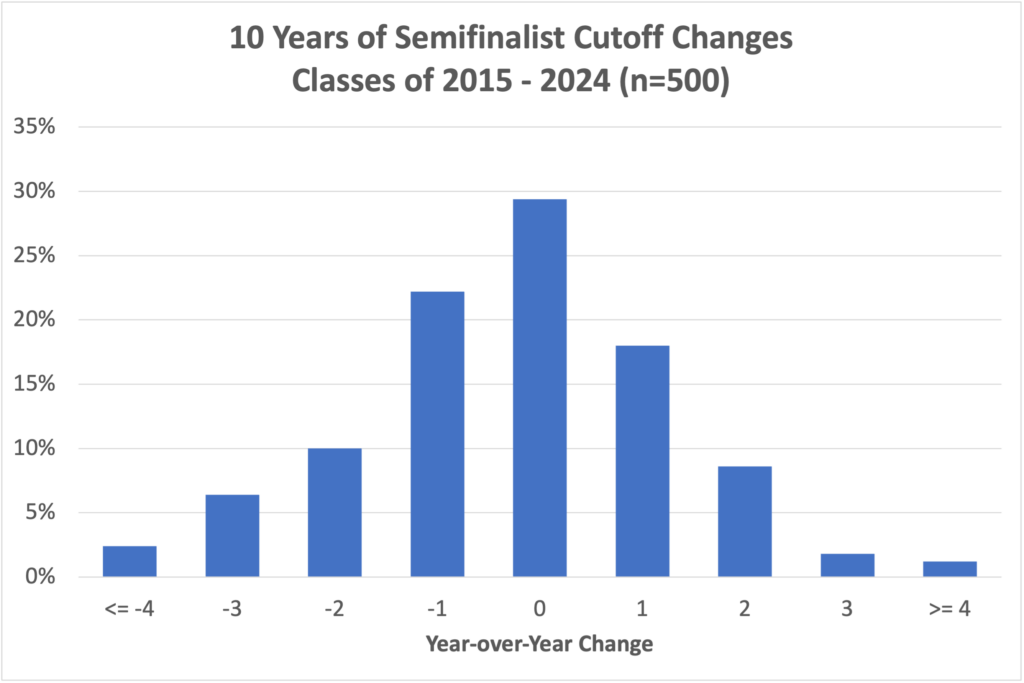
We believe that a table of results from this class will skew to the right.
Small states have more volatile cutoffs than large states, but there can be surprises across the board. The PSAT had a significant overhaul in scoring in 2017. If we look at the minimum and maximum cutoffs during the 9-year period from then until the class of 2025, we see that the 13 largest states (about 100,000 or more high school graduates) average a 2.8-point differential. New Jersey has a 1-point differential, since its lowest cutoff is 222 and highest is 223. The smallest states (fewer than 30,000 graduates) have a 6.2 point differential. Alaska has been as low as 208 and as high as 217! The medium-sized states average a 5-point difference between minimum and maximum.
Here are Compass’s current estimates for Semifinalist cutoffs for the class of 2026:
State | Class of 2026 Estimated Range | Class of 2026 Most Likely | Class of 2025 (Actual) | Class of 2024 (Actual) | Class of 2023 (Actual) | # of 2025 Semifinalists |
|---|---|---|---|---|---|---|
| Alabama | 210 - 216 | 214 | 212 | 210 | 212 | 267 |
| Alaska | 210 - 216 | 214 | 214 | 209 | 210 | 36 |
| Arizona | 215 - 220 | 218 | 217 | 216 | 214 | 401 |
| Arkansas | 210 - 215 | 213 | 213 | 210 | 210 | 134 |
| California | 220 - 223 | 222 | 221 | 221 | 220 | 2103 |
| Colorado | 216 - 221 | 218 | 218 | 216 | 217 | 272 |
| Connecticut | 220 - 222 | 221 | 221 | 221 | 221 | 177 |
| Delaware | 218 - 221 | 220 | 219 | 219 | 218 | 43 |
| District of Columbia | 222 - 224 | 223 | 223 | 223 | 223 | 47 |
| Florida | 216 - 220 | 218 | 217 | 216 | 216 | 972 |
| Georgia | 217 - 221 | 219 | 218 | 217 | 218 | 624 |
| Hawaii | 215 - 220 | 218 | 217 | 217 | 215 | 74 |
| Idaho | 212 - 217 | 214 | 213 | 211 | 215 | 102 |
| Illinois | 218 - 222 | 220 | 220 | 219 | 219 | 738 |
| Indiana | 214 - 219 | 217 | 217 | 216 | 214 | 304 |
| Iowa | 211 - 217 | 214 | 212 | 210 | 212 | 156 |
| Kansas | 213 - 219 | 216 | 215 | 214 | 214 | 142 |
| Kentucky | 211 - 217 | 214 | 213 | 211 | 212 | 202 |
| Louisiana | 212 - 217 | 215 | 214 | 214 | 213 | 238 |
| Maine | 212 - 217 | 215 | 214 | 213 | 215 | 53 |
| Maryland | 221 - 224 | 222 | 222 | 221 | 222 | 296 |
| Massachusetts | 221 - 224 | 223 | 223 | 222 | 220 | 294 |
| Michigan | 216 - 220 | 218 | 218 | 217 | 218 | 511 |
| Minnesota | 216 - 220 | 218 | 217 | 216 | 216 | 288 |
| Mississippi | 210 - 215 | 213 | 212 | 209 | 210 | 155 |
| Missouri | 214 - 218 | 216 | 215 | 214 | 213 | 276 |
| Montana | 208 - 213 | 210 | 209 | 209 | 207 | 45 |
| Nebraska | 210 - 216 | 213 | 211 | 210 | 212 | 118 |
| Nevada | 211 - 218 | 215 | 214 | 211 | 210 | 162 |
| New Hampshire | 214 - 219 | 217 | 217 | 215 | 213 | 55 |
| New Jersey | 222 - 224 | 223 | 223 | 223 | 223 | 474 |
| New Mexico | 209 - 215 | 212 | 211 | 207 | 208 | 94 |
| New York | 219 - 221 | 220 | 220 | 220 | 219 | 1089 |
| North Carolina | 216 - 220 | 218 | 218 | 217 | 217 | 518 |
| North Dakota | 209 - 213 | 210 | 210 | 207 | 209 | 28 |
| Ohio | 215 - 219 | 217 | 217 | 216 | 216 | 582 |
| Oklahoma | 209 - 215 | 212 | 211 | 208 | 211 | 214 |
| Oregon | 215 - 220 | 217 | 216 | 216 | 216 | 205 |
| Pennsylvania | 217 - 221 | 219 | 219 | 219 | 218 | 583 |
| Rhode Island | 213 - 220 | 217 | 217 | 215 | 216 | 50 |
| South Carolina | 210 - 217 | 215 | 214 | 209 | 213 | 234 |
| South Dakota | 209 - 214 | 211 | 208 | 209 | 212 | 41 |
| Tennessee | 215 - 219 | 218 | 217 | 217 | 215 | 319 |
| Texas | 218 - 221 | 220 | 219 | 219 | 219 | 1714 |
| Utah | 210 - 216 | 213 | 211 | 209 | 211 | 195 |
| Vermont | 211 - 217 | 215 | 215 | 212 | 213 | 33 |
| Virginia | 220 - 223 | 222 | 222 | 219 | 221 | 394 |
| Washington | 220 - 223 | 221 | 222 | 220 | 220 | 358 |
| West Virginia | 209 - 212 | 210 | 209 | 207 | 207 | 66 |
| Wisconsin | 213 - 217 | 215 | 214 | 213 | 213 | 289 |
| Wyoming | 209 - 213 | 211 | 209 | 207 | 207 | 24 |
| U.S. Territories | 209 - 211 | 210 | 208 | 207 | 207 | 45 |
| Studying Abroad | 222 - 224 | 223 | 223 | 223 | 223 | 112 |
| Commended | 209 - 211 | 210 | 208 | 207 | 207 |
If you’d like to see even more historical data, you can find cutoffs going back to 2008 in Compass’s National Merit Historical Cutoffs.
Why does each state have its own Semifinalist cutoff if the program is NATIONAL Merit?
This is always a hot button question. NMSC allocates the approximately 17,000 Semifinalists among states based on the annual number of high school graduates. That way, students across the nation are represented. It also means that there are very different qualifying standards from state to state. A Massachusetts student with a 220 might miss out on being a Semifinalist. If she lived 10 miles away in New Hampshire, she would qualify.
NMSC sets a target number of Semifinalists for a state. For example, California sees about 2,000 Semifinalists every year, Michigan 500, and Wyoming 25. In each state, NMSC determines the Selection Index that comes closest to matching its target number of Semifinalists. If 1,900 California students score 222 and higher and 2,050 score 221 or higher, then the Semifinalist cutoff would be 221 (this assumes that the target is exactly 2,000). Because score levels can get crowded, it is easy for cutoffs to move up or down a point even when there is minimal change in testing behavior or performance.
No Semifinalist cutoff can be lower than the national Commended level. Cutoffs for the District of Columbia and for U.S. students studying abroad are set at the highest state cutoff (typically New Jersey). The cutoff for students in U.S. territories and possessions falls at the Commended level each year. Boarding schools are grouped by region. The cutoff for a given region is the highest state cutoff within the region.
Why does the number of top scorers vary from year to year?
While there are changes in the number of students taking the PSAT/NMSQT, there can also be small flaws in test scaling that play a role. Prior to the digital PSAT, a single test form was seen by a large percentage of test takers. Something amiss with that single form could impact selection cutoffs across the country. The digital PSAT is constructed differently. Students receive unique form codes drawn from a large pool of problems. Scaled scores are generated based on the characteristics of those problems. In theory, this should make scores more stable. College Board’s early studies have found an extremely high correlation between the paper-and-pencil test and digital test. Still, even with its adaptive nature, the uncertainty remains as to whether the much shorter test can reliably score students at the 700-760 end of the scale.
What if I missed the PSAT because of illness or other legitimate reason?
You may still be able to enter the scholarship program by applying for Alternate Entry using an SAT score. Find information about last year’s process in Compass’s explanation of National Merit alternate entry.
When are National Merit Semifinalists announced?
The Commended cutoff becomes unofficially known by the end of April. The lists of Semifinalists are not distributed to high schools until the end of August. NMSC sets a press embargo on Semifinalist announcement until mid-September, but schools are allowed to notify students before that date. NMSC does not send Commended Student letters to high schools until mid-September. Compass will keep students updated on developments as those dates approach.
Do state and national percentiles indicate whether I will be a National Merit Semifinalist?
No! Approximately 1% of test takers qualify as Semifinalists each year, so it is tempting to view a 99th percentile score as indicating a high enough score — especially now that College Board provides students with percentiles by state. There are any number of flaws that rule out using percentiles as a quick way of determining National Merit status.
- Percentiles are based on section scores or total score, not Selection Index
- Percentiles are rounded. There is a large difference, from a National Merit perspective, between the top 0.51% and the top 1.49%
- Percentiles reveal the percentage of students at or below a certain score, but the “at” part is important when NMSC is determining cutoffs.
- The number of Semifinalists is based on the number of high school graduates in a state, not the number of PSAT takers. Percentiles are based on PSAT takers. States have widely varying participation rates.
- Most definitive of all: Percentiles do not reflect the current year’s scores! They are based on the prior 3 years’ performance. They are set even before the test is given. And if you are going to use prior history, why not use the completely accurate record of prior National Merit cutoffs rather than the highly suspect percentiles?
Entry requirements for National Merit versus qualifying for National Merit.
Your PSAT/NMSQT score report tells you whether you meet the eligibility requirements for the NMSP. In general, juniors taking the October PSAT are eligible. If you have an asterisk next to your Selection Index, it means that your answers to the entrance questions have made you ineligible. Your answers are conveniently noted on your score report. If you think there is an error, you will also find instructions on how to contact NMSC. Meeting the eligibility requirements simply means that your score will be considered. Approximately 1.4 million students enter the competition each year. Only about 53,000 students will be named as Commended Students, Semifinalists, Finalists, or Scholars. See National Merit Explained for more information.

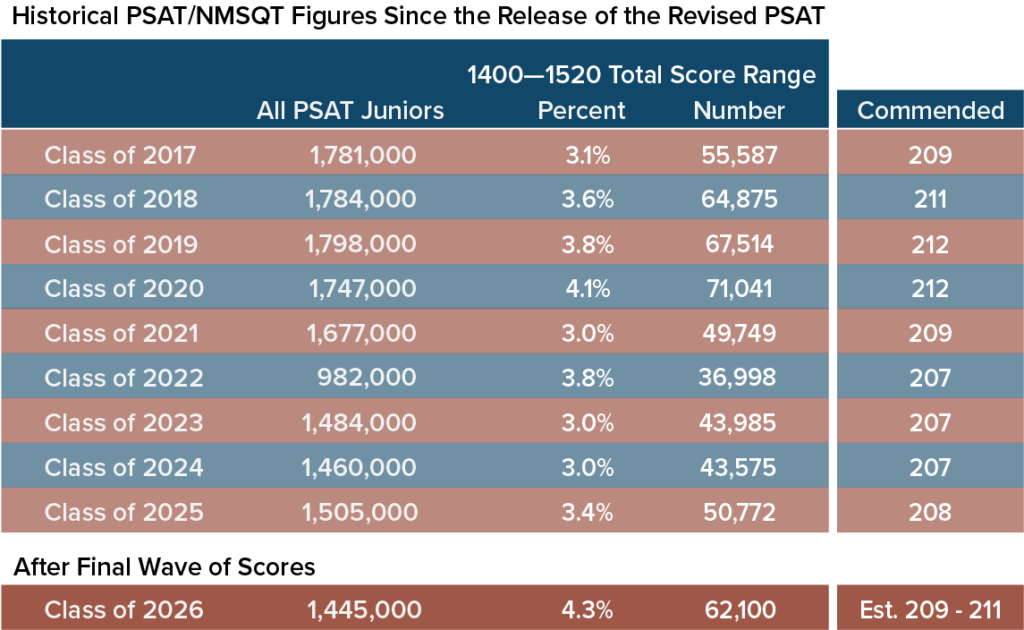
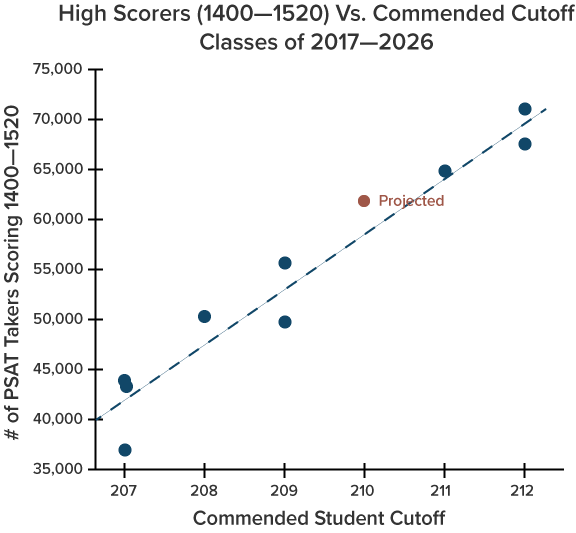
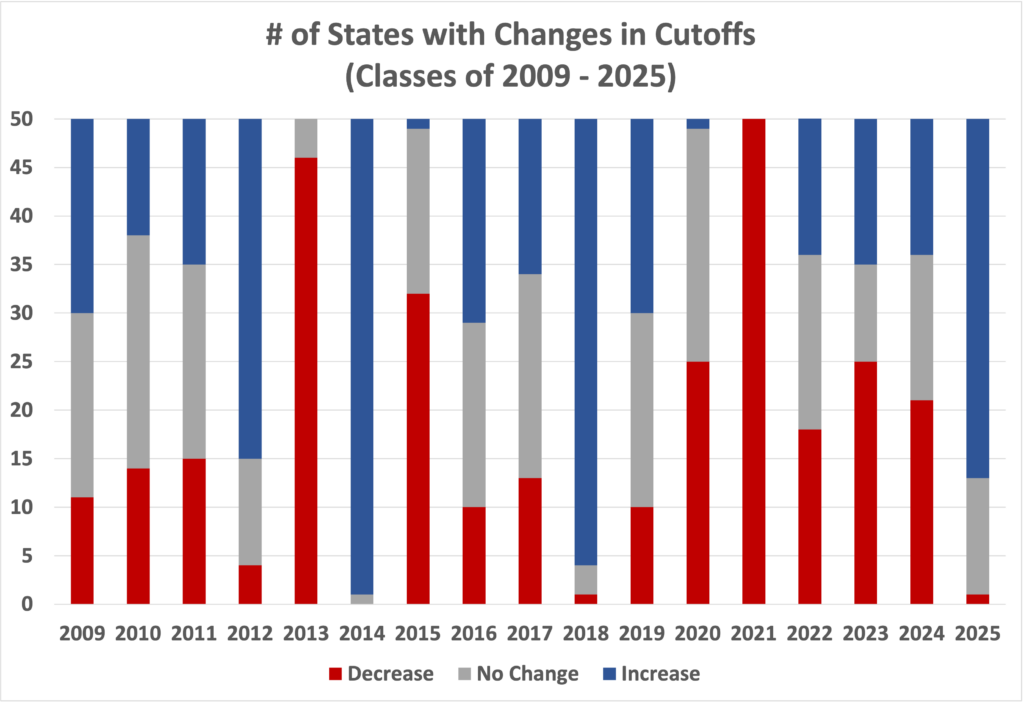
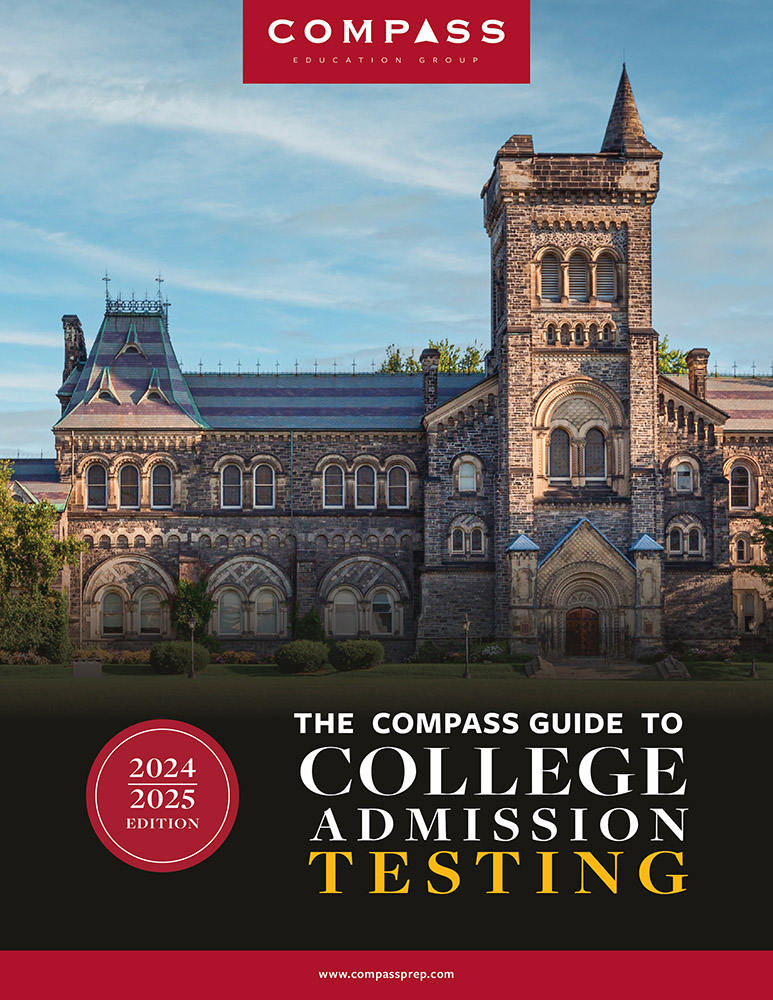
Hello,
My 10th grade daughter got a 210 index score (700 on each section). How much improvement would you generally expect to see by next year?
Johnny,
Improvement varies greatly depending on how much work your daughter does. The average gain for a Selection Index from sophomore year to junior year is about 8 points.
Hello, Sawyer,
My daughter received a 223 (English 740, Math 750 total 1490). We live in California. and she got an SAT 1540 in March and that score was in 10th grade. Does she need a New SAT score in 11th grade? Do you believe her score is sufficient to advance him to the 2026 semifinals? Your ideas. Thank you!
Flavia,
Congratulations to your daughter! Yes, I’m confident that 223 will qualify her as a Semifinalist. The SAT score is needed at the Finalist stage. The cutoff there is set nationally, usually at the Commended level. In other words, the highest it would go is an SAT Selection Index of 212. Your daughter’s score is well above that. And, yes, an SAT can be taken as early as fall of sophomore year. So she is all set!
Hi,
Thank you for such an informative article. My son saw his PSAT score today and his selection index is 218. We live in Tennessee. I saw the estimates for our state, but I was wondering what you think my son’s chances are of achieving Semi-Finalist status for the class of 2026?
Also, do you know when the actual cutoff scores for each state will be released?
Thanks for your time.
Cheryl,
While a 218 would have qualified in the last 5 classes, this year is looking strong. Even in 2017-2020 period, though, Tennessee’s cutoff only hit 219 twice. I’d put your sons chances at about 70/30.
Hello
My daughter received a 224 yesterday in NJ (English 740 Math 760). Will she be qualified as a Semifinalist? Any probability of NJ cutoff jumping to 225, given the upward trend? Thank you so much.
YH,
Your daughter will be a Semifinalist. Congratulations! Even in an up year, we won’t see a 225 cutoff. Really the only question is whether or not New Jersey will finally hit 224.
Hi! I got a 1380 (740 RW, 640 M) with an index of 212, is commended guaranteed? My state is very competitive, so I know I will not be a semifinalist. I just want to know if I have a high (practically guaranteed) shot at being a national commended scholar!
Brielle,
I feel more comfortable with the “practically guaranteed.” We haven’t seen a 213 cutoff before, and I don’t think we’ll see it this year. I have just caution not to call it guaranteed guaranteed, especially before we see the last wave of scores.
Hi,
What are the chances of a student who got PSAT1490 (index 222) in California being qualified as a 2026 semifinalist? Thank you!
NL,
You’ve got two important factors working in your favor (1) California’s cutoff has only hit 223 once (in a year when there were 71K high scorers nationally) and (2) California’s PSAT-taking figures have weakened since then. I’d say your chances are in the 90-95% range.
My daughter has a score of 222 in California. I see that the upper range of prediction to be 223? How likely is she to be a semifinalist?
Ray,
I’ll quote myself from another reply on this same situation:
“You’ve got two important factors working in your favor (1) California’s cutoff has only hit 223 once (in a year when there were 71K high scorers nationally) and (2) California’s PSAT-taking figures have weakened since then. I’d say your chances are in the 90-95% range.”
Hi
Would you consider 218 likely to make the cutoff in AZ for class of 2026
Thanks in advance for your response
AJ
Anand,
The situation in Arizona is similar to what we’ve seen in many states — a 218 would have qualified in the last 5 class years. That’s the good news! The strong numbers so far, though, make me concerned that this class will be more similar to the 2017 – 2020 period, when Arizona’s cutoff went as high as 220. Based on the information that I have today, I’d say it’s about 50/50.
Art,
I just wanted to jump in on the Arizona question. You have the most likely at 217…so curious as to why you now think it likely that this year will be similar to a 220 year for AZ? Did something change since you felt 217 was most likely?
All of your information is greatly appreciated!!
Davis
Davis,
Sorry that I was unclear. I was really just thinking out loud in response to Anand’s 218. I still have Arizona’s most likely at 217. Although, TBH, I’d be tempted to shift that to a 218 depending on how the final wave of scores shake out. By “make me concerned that…” I really meant that it’s a consideration when estimating the most likely and the estimated range. Arizona was at 219 and 220 during that run. I don’t want, in other words, a “most likely” to be misinterpreted as “it’s in the bag.”
My daughter has a score of 228 in NY. How do she to be a finalist?
Wayne,
Congratulations to your daughter! With a 228, she will be named as a Semifinalist in September. She will get access to an online application to become a Finalist. She will need what is referred to as a “confirming” SAT or ACT score. That score is a nationwide level that will be an SAT Selection Index of 210-212 in all likelihood. In other words, it should be easy for her. The other requirements are excellent grades (NM gives no cutoffs there), a school recommendation, and an essay. Most Semifinalists do become Finalists (named in January 2026).
Florida. What chance would you give Florida of bumping to a 220 or higher for current juniors? Your historical data (thank you!!) shows Florida has never gone over 219 nor had more than a 2-point leap in a year. Could the strong national upward trends drive FL up, or does the fact it’s a large state keep it in check?
Jane,
You’ve basically taken away anything that I could add by accurately summarizing the situation! I think a 220 is very unlikely in Florida, but I don’t think it can be ruled out entirely. 5% chance?
Hi Art, Thank you for taking the time to assuage many nerves nationwide. My daughter has a 218 in Florida (710V, 760M). Might this be Commended, if not Semi-Finalist?
CMM,
Yes, if your daughter misses out on Semifinalist, her score will be well above the Commended cutoff.
Art,
Appreciate all you do, and your patience answering what seem like very similar questions. My daughter is in Georgia and received. 219. I’ve been following your article above and see with the newest scores, the projected threshold moved from 218->219. I know your estimated range goes up to 221 for the state. My questions are:
1) How likely is it that we’ll see a cutoff of 220 or higher?
2) If she were to make the cutoff, is she then compared to other kids at her school when being considered for finalist status? Or is it strictly at the state level?
Thanks!!
Matt,
I think I answered (1) of this just a moment ago (apologies if that wasn’t you), but I neglected to answer (2). No, she is not competing versus other students at her school — directly, at least. The school recommendation is part of the Finalist process. Keep in mind that most Semifinalists qualify as Finalists. Good grades, confirming SAT score, nose clean, and an essay.
1470, 760 in math and unfortunately, lower in RW leading to an index of 218 in New York. What are the chances of commendation? I understand being a semifinalist is impossible.
NS,
Commended Student is a lock. It’s extremely unlikely that it will move above 212, and there is no chance that it would move above 213. I should have a better estimate after the final set of scores. My guess is that we are going to see a 210 or 211.
Hi,
My daughter got full score 1520 (index 228) in Idaho. But does that ensure her being a Semifinalist? Or still, the score just makes her “qualified/eligible” to potentially be a Semifinalist, and whether or not she actually make it next Sep is still up in the air?
Bright
bright,
Congratulations to your daughter! Yes, she will be a Semifinalist. The next stage happens in September after Semifinalists are officially announced. She will submit an application to become a Finalist. At that stage, it is not longer about scores, it is about grades, school recommendation, and essay. Oh, she will also need a “confirming” SAT score, but that won’t require much more than a 1410-1430, so I’m sure that she won’t have any problem there. And that is considered a sort of pass/fail. It doesn’t matter to what extent she exceeds the minimum.
Hello Mr. Sawyer,
I scored a 217 Selection Index, which is listed as “most likely” for Tennessee. However, my overall score (760 RW + 650 M = 1410 Total) places me in the 96th percentile for TN.
I understand my high SI is due to my strong RW score being weighted more heavily, but I’m concerned that state cutoffs might be higher this year, as my percentile is lower than the typical top 1% for NMSF qualification.
Thank you for any possible clarification!
Elton,
When it comes to National Merit, I really hate percentiles. First, they tell us absolutely nothing about this years’ cutoffs, because they are based on the 3 prior classes. That’s right, they have nothing to do with the class of 2026 performance! And, as you pointed out, they don’t factor in the SI, which is vital. Also, every state’s participation level is different. If every student in every state took the PSAT, then we could approximately say that the top 1% of students qualify in each state. But not every student takes the PSAT and the composition of test takers is different in every state. All of which is to say, don’t put any stock in percentiles.
I wish I could tell you that there is no reason to be concerned — not because of percentiles but because of Tennessee’s history. In some “up” years, TN’s cutoff has gone to 218/219. So I still consider it something of a 50/50 proposition for a 217 to qualify this year.
A Maine score of 216 seems likely she will be a semifinalist for the class of 2026, but it doesn’t seem guaranteed because your estimated range goes up to 217? Maine was at 213 for class of 2024 and 214 for class of 2025. Thank you for this info! It’s very helpful and we saw a note on college board that she was eligible for national merit scholarship so we automatically thought she made it, and now we realize we won’t know until next fall.
AM,
The eligibility information is confusing. You’re right. That basically just confirms that your daughter is listed as a junior and is automatically entered into the NMSP.
States evolve, so I definitely take recency into account. That makes a 216 look fabulous. Relatively speaking, though, we haven’t seen this many high scorers since the classes of 2017-2020. And during that period, Maine got as high as 217 (2019). But the next year — even though there were more high scorers, it fell back to 215. In other words, small states can bounce around. Yes, there is still that chance that it could bounce to 217, but I like your daughter’s chances.
What do you think of a 221 in Texas? Thank you
Richie,
It’s almost a guarantee. Texas would need to set a new record to reach 222, and the national scores don’t seem high enough for the second largest state in the country to do that. It’s 99% territory.
Do you think it’s possible that California’s cutoff could drop to 220?
Vihan,
I like to stay positive, but I also believe in honesty. I think there is a small chance that California drops to 220. While it seems to be a strong years for scores overall, we have seen weakness in recent years on the appetite for testing at some CA schools. I don’t think I’d put it higher than a 10-15% chance. 221 or 222 are more likely.
Hello,
I’m a junior and got a score of 1490 (222 index) for the PSAT this year, in the state of Texas. Will I almost guaranteed become at least a National Merit Semi-Finalist or is there a chance it could jump up to where I would only become Commended?
Thanks!
Sam,
I can’t remember if your question was the one I answered a few minutes ago, but I can give you the same answer: you will be a Semifinalist. Congratulations!
Hi! I just got back my score in Maryland – it’s a 1520 (760 math, 760 reading) and an index of 228. Is this a guaranteed scholarship?
Kat,
Congratulations! You are guaranteed Semifinalist status. Getting to Finalist and scholarship are a little different. All Semifinalists are considered equal in their state, so there is no advantage to your perfect score. You’ll need good grades and a school recommendation. You’ll also submit an essay. You need to get a high enough score on the SAT or ACT (basically a Selection Index of 212 or so). Most Semifinalists become Finalists. About half of Finalists receive scholarships, and about half of those depend on choosing, as first choice, a college that provides NM scholarships. Sorry if that answer was longer than you wanted!
Hello my child received an index score of 222 on the PSAT in Illinois. Is there any chance the cutoff could raise to 223? Thank you very much.
WS,
I just told a Texas student that a 223 was impossible in their state because it would represent a large state going up 3 points over its maximum at the high end of the range. The same is mostly true of Illinois except a 223 is 2 points above its all-time high. So I might dial it back from guaranteed to almost guaranteed. 99.8% to put a fake number on it. It would require a whole lot of unlikely events to align.
Hello,
Thanks for this amazing resource! I just a question regarding my PSAT score. I got a 1490 on this year’s PSAT with a index of 222. Are you confident that with this score in the state of Texas that I will become at least a semi-finalist? In other words is there any chance that Texas jumps up to a cutoff of 223 for this year?
Thanks!
No chance. The second largest state moving 3 points above its previous high? That doesn’t happen. Congratulations!
My son got 208/1420 in PSAT and in state of texas 2024 the college board states he met criteria for consideration into national merit. Does it mean he will be in commended category ?
Thank you.
Brian,
Unfortunately, 208 may not be enough for Commended this year. We are seeing a lot of strong scores nationally.
Hello
My daughter received a 223 in MA. Do you think the score is enough for her being a semifinalist for 2026?
Thanks for your time
Youngran,
I think there is a very high chance it will be sufficient. But if I look at the states that have a small chance of hitting 224 in a strong year, #1 is New Jersey and #2 is Massachusetts. I’d put your daughter’s odds at 95%+.
Hi, my daughter scored a 1460 in Florida with an index score of 220. How likely is she to be a semifinalist? Thank you!
Rachel,
She will be a Semifinalist. I don’t see any chance that Florida will move higher than 220. Congratulations!
Hello,
Any chance that a 209 gets a National Merit Commendation? I see that you predicted 210, but is there also a high chance that the commended cut off is 209 or lower?
Jake,
I think there is a chance. Whether it is a good chance or an outside chance depends on home many 1400-1520 scores we see in the final batch this week.
Ok, thank you so much for the reply.